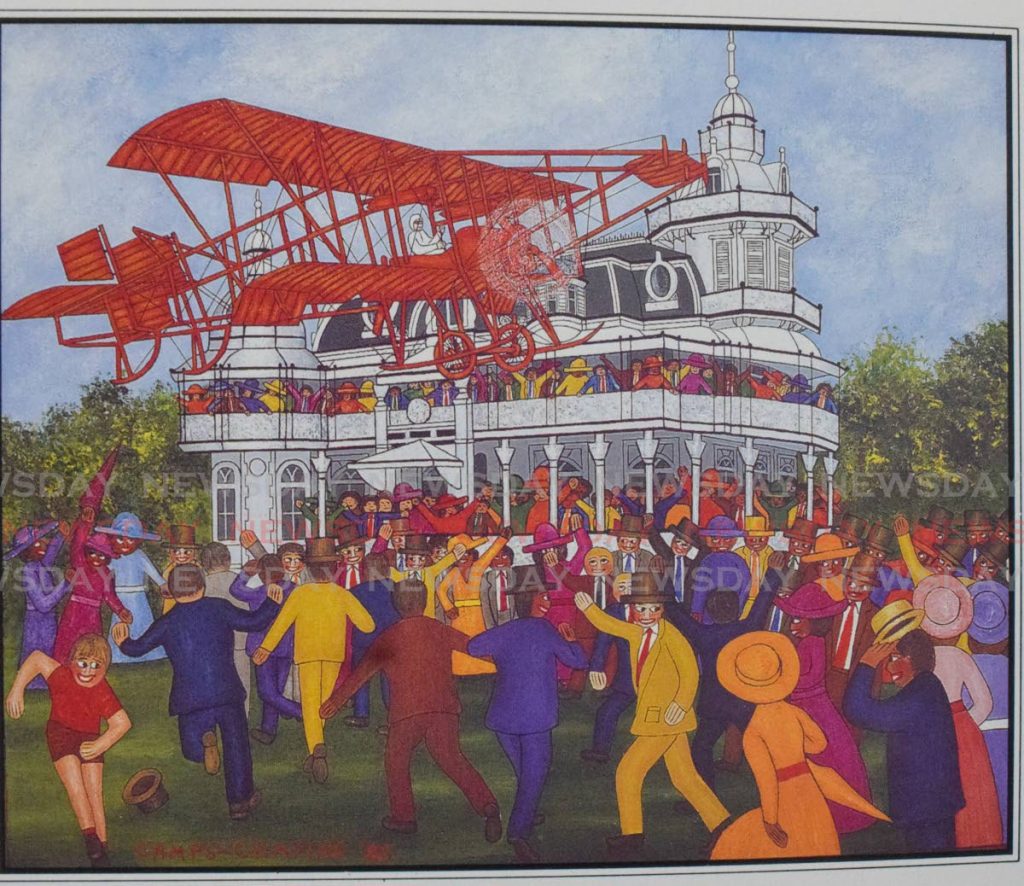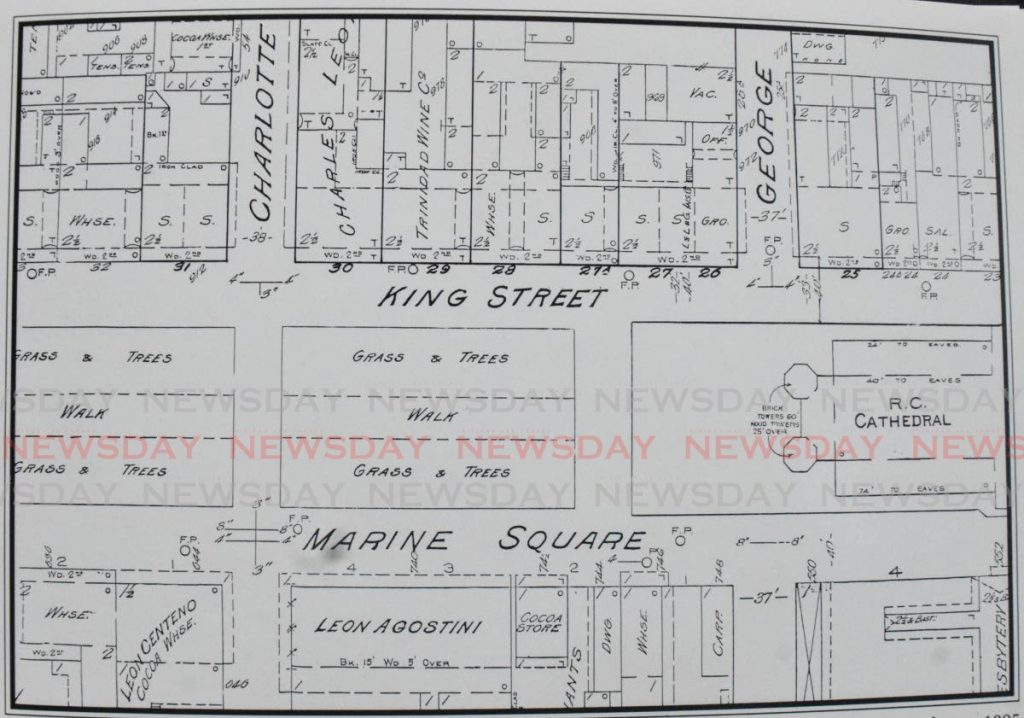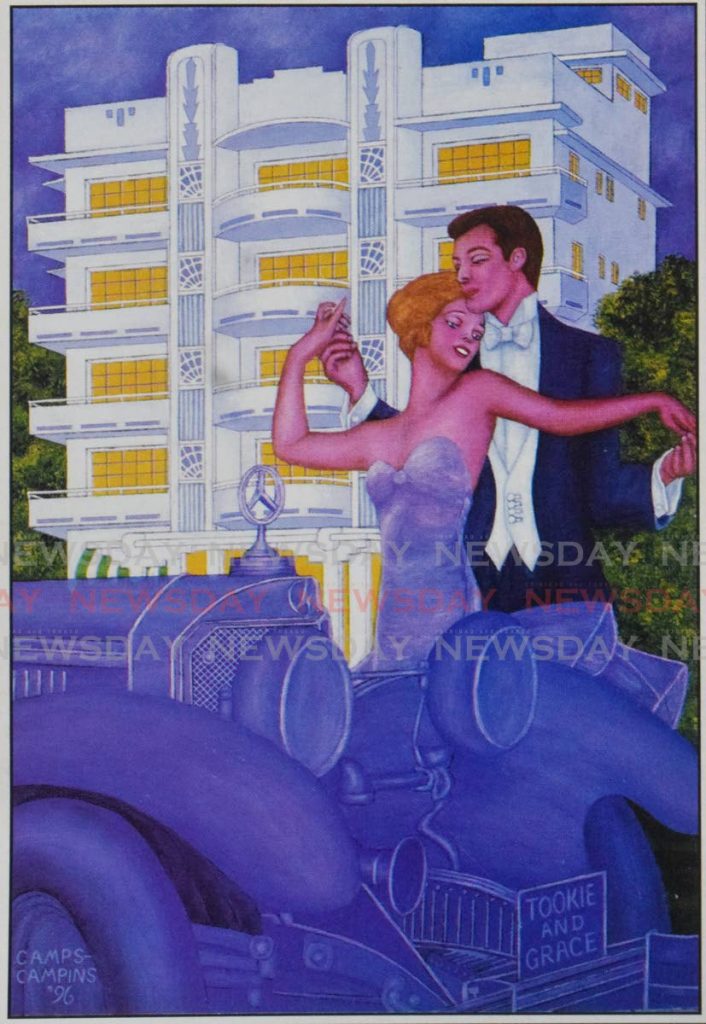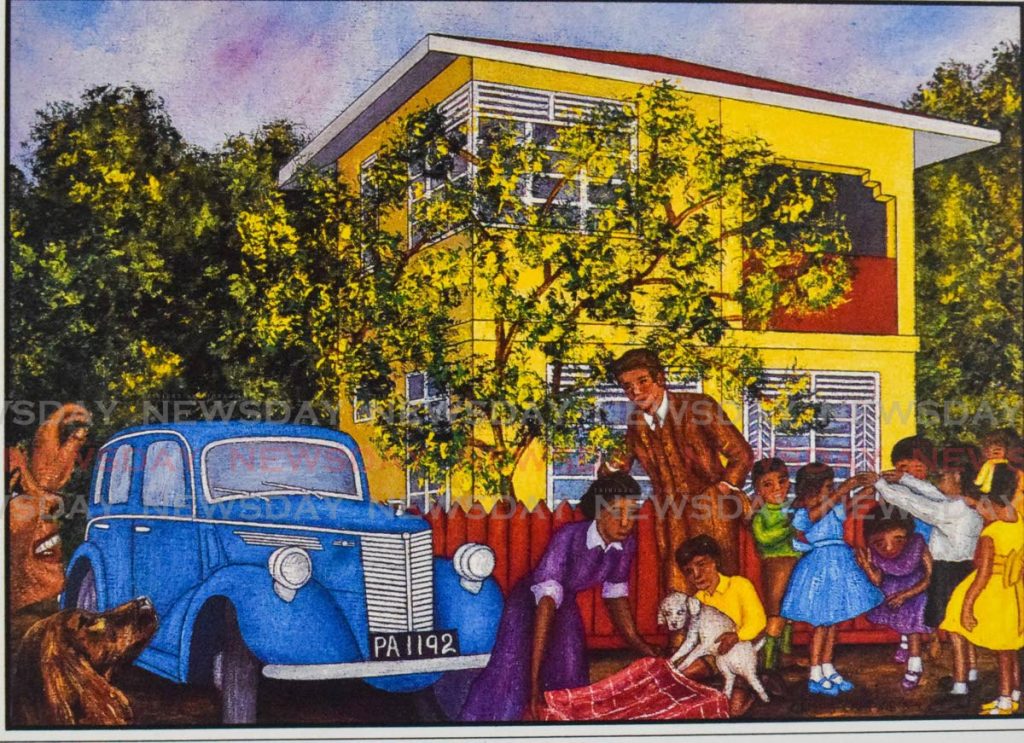Adrian Camps-Campins tells TT's history in paintings

Adrian Camps-Campins, who died on January 11, aged 76, was well known for his brightly coloured historical paintings.
Rarely shown in exhibitions, they were made widely accessible in the form of greeting cards. The paintings themselves are all over the world, too, many in the collections of diplomats once based in TT, who took them home as mementoes of their time here.
Usually set in some distant and ostensibly happier time – often the early 20th century – a typical Camps-Campins scene showed celebratory crowds in the foreground, overlooked by what we now call a heritage building.
He described his style as “sophisticated naïve.” His paintings are entertaining and generally cheerful to look at, but far from artistically brilliant. Though he once painted portraits, many of the people in his tableaux are barely more than stick figures.
He himself would dismiss those parts of his paintings – “This is amateurish” – and point out instead some aspect of the tranquil, stately edifice in the background.
Camps-Campins painted three to six paintings a year, working on them one or two at a time, in the mornings, in the first-floor studio of his house on a quiet side street in Maraval. He used acrylics on plywood – sometimes a sheet as large as eight feet by four, so he could reproduce architectural features in detail. But the paintings weren’t only about the buildings.
When Camps-Campins printed his paintings on cards, they were accompanied by archival photos and historical information. And it’s as an historian that he was really important, says Jerry Besson, himself an antiquarian.
Camps-Campins’s 1980 painting of the George Brown House at the corner of Queen’s Park West and Victoria Avenue includes eight photos of Brown – the Scots architect who changed the face of Port of Spain in the late 19th century – and his family. There’s a history of Brown’s Trinidad career and of the house: Brown built it for the Siegert family, and his own daughter Jessie Simpson later lived there.
In a painting of a cricket match at the Queen’s Park Oval, Audrey Jeffers’s house on Sweet Briar Road can be seen beyond the pitch. The card features a photo from a 1930 Test played in the Oval, with Learie Constantine fielding at gully.

Special trains were put on to bring people to witness George Schmidt, who came to Trinidad to give a flying exhibition in his biplane the Red Devil, taking off in front of the Queen’s Park Hotel on February 28. In the background is “Roomor” or Ambard’s House, one of the Magnificent Seven.
-
The historical details on the cards came from Camps-Campins’s own research and records. His studio held shelves of history books, photocopies of rare books and historical records. If you took down two at random, you might find yourself holding a book on the sea fish of Trinidad and a volume of the baptismal records from the Cathedral of the Immaculate Conception, dating from 1784-1806.
(Camps-Campins commented, “These were the children of the people who came under the Cedula of Population.” He pointed out that the children were recorded under three headings:
blancos, pardos libres and esclavos: white, free coloured and enslaved.)
In the cupboards in his studio were stacked the thousands of photographs he gathered over more than 40 years, filed by subject. In the 1970s, when he became a professional artist, he would photograph old buildings every weekend. He asked people he met if they had any old family photo albums, and copied the contents.
“There’s lots of old stuff around,” he told me in a 1995 interview. “People have boxes of historical stuff at home…I always have my antennae out.”
Many of the 19th-century photos that Camps-Campins collected can also be found elsewhere, but the rest of his archive, says Besson, is “very, very important.”
“I hope it’s kept and not thrown away. He had dozens and dozens of notebooks. He interviewed a lot of people and wrote their stories…That’s why he was able to fill those cards. If you took all the stories on all the cards, (they) would fill several hundred pages.”
UWI historian Prof Bridget Brereton describes his archive as including a “very fine library,” as well as a wonderful collection of photographs, postcards and other documents, which should be preserved in the National Library or at UWI.
Both Brereton and Besson stress that it was for his historical work, not his paintings, that UWI awarded Camps-Campins an honorary doctorate in 2014.

“He was a true historian,” said Besson. “He was recognised by his peers for the work he had done. He deserved it.”
Camps-Campins collaborated on books by Fr Anthony de Verteuil, doyen of local historians; de Verteuil was one of the officiants at Camps-Campins’s funeral on January 17.
Besson himself met Camps-Campins in the late 1970s, at the Boos house (now Jenny’s) on Cipriani Boulevard, home of Olga Mavrogordato. She was the author of Voices in the Street, the 1977 work that made popular local, non-academic history. Camps-Campins and Besson were part of the small group who went to her informal history school on Saturday mornings.
“Adrian was reading Trinidad history from scratch,” recalled Besson. “Borde, EL Joseph…He read all the newspaper files in the national archives.”
Besson finds it hard to imagine the patience required for that task.
“Adrian was obsessive,” he concludes.
Camps-Campins would have agreed. “People tell me, ‘You talk too much history, you’re living in the past too much,” he admitted.
He was interested in everything to do with Trinidad history, especially the 1920s and 30s. But whatever old material he was offered, “I’m inclined to take it.” Brereton called him “a magpie.”

Housing developer Tookie Collens rebuilt the Queen’s Park Hotel to the Art Deco design of American architect William Brown. Camps-Campins included in his card an account of Tookie’s career written by Grace Collens, his widow. -
Many of his paintings fell into the category of what she has dubbed “French Creole history,” and depicted the colonial elites making merry, dancing or watching the races. While he researched and brought to life mainly a “traditional, upper-class” slice of local history, that limited slice was important, Brereton says. His historical knowledge, primarily recorded in his paintings, was based on “extremely meticulous and detailed research,” from both archival and visual sources, shared in his cards.
Camps-Campins knew not everyone would appreciate images such as his painting of his aunt Ethel Grell’s 1925 wedding reception at the Seheult house in St Clair, with Queen’s Royal College and massed mansions beyond.
“This one is very French Creole, and that offends some people,” he said of it. “If I see a building I’d like to do, I put who built it, and some people don’t like that.”
In fact his range was wider. He painted a fleet of French privateers being destroyed by the British off Gasparee in 1796; English redcoats marching on Port of Spain nine months later. He portrayed the Naipaul house on Nepaul Street, St James, in its days as The House for Mr Biswas in 1946. He painted the Twin Towers, and the Hindu mandir in Tunapuna.

Sir Ellis Clarke commissioned him to paint Lazdale, the home of the Afro-Trinidadian lawyer Mzumbo Lazare (1864-1929), which Sir Ellis had inherited (it stood at the corner of Simeon Road, Petit Valley, now the site of a church). When Camps-Campins was asked to paint the Lion House, the Capildeo family home in Chaguanas, VS Naipaul’s sister Kamla Tewari helped him with the research.
The painting he considered his best, from 1978, showed a 1910 polo match in the Savannah, with the newly built Magnificent Seven in the background. It was, he says, the first time anyone had included all seven in one painting.
A few years before, Camps-Campins had been an insurance underwriter. But he promised himself if he failed his insurance exams, he would become an artist.
The rest is literally history. His 1973 painting of the arrival of Columbus was chosen for a postage stamp in 1977. He sold 100 or so copies of the card (by the 1990s he was printing up to 15,000 a year). His first success, in 1975, was a card bearing a painting of a 1912 race meeting. On the southern side of the Savannah you can see the Prince’s Building (on the site of NAPA), Knowsley, and the original Queen’s Park Hotel. Mrs Mavrogordato helped him with the research.
The card established his style, and proved “a turning point in my career in terms of recognition,” he said.
One reason that Camps-Campins was able to gather so much material was that, Besson says, “He was friends with all sorts of people.” He would go to exhibitions and receptions to meet diplomats and other potential buyers of his work; but looking at photos of such occasions, he said, “I don’t like the limelight. You see all of this? I hate it, hate it.”
Until a few years ago, Camps-Campins was a gently smiling, seemingly ageless figure, usually wearing jeans, his unruly hair scarcely frosted with grey. He lived alone, and for all his sociability, he had an other-worldly air. You felt he was happiest in his own company, combing through a pile of documents to make sure he got the niceties of his paintings right, wrapped comfortably in the past.
But he often invited to tea fellow history enthusiasts and people (like me) whom he generously allowed to draw on his archival material.
Besson describes him as a “courtly, old-fashioned gentleman.” At his funeral, his friend Robert Boos (nephew of Olga Mavrogordato), who gave the eulogy, called him an eccentric. And then the mourners followed Camps-Campins’s coffin down the aisle to the strains of an unusual “recessional hymn” – Irving Berlin’s Puttin’ on the Ritz.

Comments
"Adrian Camps-Campins tells TT’s history in paintings"